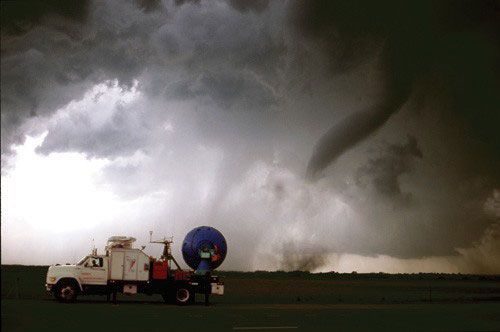[dt_button link=”http://d165vjqq8ey7jy.cloudfront.net/mp3/27274/se-7791s.mp3″ target_blank=”true” button_alignment=”default” animation=”fadeIn” size=”small” style=”default” bg_color_style=”custom” bg_color=”#333333″ bg_hover_color_style=”custom” bg_hover_color=”#444444″ text_color_style=”custom” text_color=”#ffffff” text_hover_color_style=”custom” text_hover_color=”#dddddd” icon=”fa fa-cloud-download” icon_align=”left”]Yuklash[/dt_button]
[dt_divider style=”thin” /]
Transcript:
Voice 1
Welcome to Spotlight. I’m Katy Blake.
Voice 2
And I’m Liz Waid. Spotlight uses a special English method of broadcasting. It is easier for people to understand, no matter where in the world they live.
Voice 1
The warning comes on the radio – a tornado is coming. The storm is moving quickly. It is very dangerous. The voice on the radio warns you to find shelter. The storm is coming. The dark clouds in the sky seem to be rolling. It is raining. The loud wind blows trees and plants. You gather your family and find a safe shelter.
Voice 2
This is the experience of many people around the world when they hear that a tornado is coming. These dangerous storms can destroy whole cities. Tornadoes are the most violent of any kind of storm. In a tornado, the wind forms a funnel. It moves in a circle, forming a kind of tube. The tube is usually wider at the top, and thinner at the bottom.
Voice 1
When most people know a tornado is coming, they find shelter. But there are some people who do not find shelter. In fact, they travel toward the storm! These men and women chase storms like tornadoes. But why do they do this? Are these men and women insane or brave? Today’s Spotlight is on storm chasers.
Voice 2
Tornadoes happen all over the world. But they are especially common in the United States and Bangladesh. There is a wide area through the middle of the United States where tornadoes are especially common. Experts even call it “tornado alley”. In Bangladesh, tornadoes are also common and deadly. In the past, 19 tornadoes have each killed more than 100 people there.
Voice 1
Storm chasers follow these tornadoes in all places tornadoes happen. In the United States, storm chasing began in the 1950s. Chasers listened to weather reports on radios. The chasers drove to the places where the storm was. Then they took pictures.
Voice 2
However, technology continued to improve. Today, storm chasers often have high-quality video recorders and cameras. They can use satellite information. They can use their mobile phones to connect to the internet. This helps them predict, or estimate, where the storms will go. Often storm chasers also have special vehicles. They protect their vehicles with extra pieces of metal. They also add specialized equipment.
Voice 1
Much of this equipment gathers information about tornadoes. This information helps weather experts know when a tornado will form. Howard Bluestein is a meteorology professor at the University of Oklahoma. Meteorology is the study of the atmosphere and weather. Bluestein sees great value in studying tornadoes. He told National Geographic magazine:
Voice 3
“Things like pressure and temperature and humidity – there is no other way to measure these things. You must make measurements inside the tornado. You need to be on the ground.”
Voice 2
Getting this information means getting extremely close to a tornado. People who get that close risk death. Greg Forbes is a severe weather expert. He told USA Today:
Voice 4
“Storm chasing is not something to be taken lightly. Sometimes you chase the tornado. And sometimes you get in the position where the tornado chases you.”
Voice 1
Mike Bettes works for the Weather Channel in the United States. This television channel concentrates on weather all over the country. Bettes is an experienced storm chaser. On May 31, 2013, he was chasing a tornado. He was travelling in a storm-chasing truck with a few other crew members. Suddenly the tornado picked up their vehicle off of the ground. Bettes says it was the most frightening time of his life. He told the CNN news organization about his experience.
Voice 5
“I imagined people in my life. I saw their faces appear before me. It just seemed for a minute that everything was moving slowly, especially when we were floating in the wind. I kind of felt like I was being lifted to heaven. I remember the whole thing, but it still seems like it was not real.”
Voice 2
The tornado dropped Bettes’ truck 180 meters away. His crew survived. But one man broke a few bones.
Voice 1
Many storm chasers are researchers like Bettes. They provide valuable information about tornadoes and other large storms. This information can help warn people when they need to find a safe shelter. People need to find shelter during tornadoes. However, many people do not listen to warnings about tornadoes. Weather experts advise people to seek shelter. But sometimes the tornado does not appear. Or it breaks up before it causes damage. When people hear the tornado warnings often, they believe they do not have to find shelter. But, when they finally see the tornado it is too late.
Voice 2
This is one reason Bettes thinks storm chasing is so important. When people see the live videos and recent pictures from a storm chaser, they believe that a tornado is coming. They are more likely to find shelter. He says:
Voice 5
“We show weather, and we like to be out there and show people what tornadoes can do. We help give warning. Storm spotters serve a very valuable purpose. Seeing it in person, and giving that real time information, I think that really adds to the warning. It helps people take shelter earlier.”
Voice 1
Some people are concerned that there are too many storm chasers. Some storm chasers want to experience the amazing excitement of being close to a tornado. But they may not have the training, equipment, or experience to stay safe. Tornadoes can change direction very quickly. The chaser could get caught in the storm, like Bettes. Too many storm chasers can also cause traffic problems. Storm chasers drive toward the storm. But other people are driving away from the storm. Betsy Randolph is a police officer in Oklahoma. She told USA Today:
Voice 6
“When storm chasers put themselves in harm’s way to chase the storms they make it harder for us. We are trying to work around more people on the highway. We are trying to rescue more people. And sometimes, the storm chasers end up being part of the problem.”
Voice 2
Some authorities have even suggested making rules about who can chase storms. Many storm chasers believe this is a bad idea. They see value in what they do. Cameron Redwine is a storm chaser in the United States. He takes pictures of storms for magazines. He sees the destruction tornadoes cause. But he also sees their beauty and power. He told USA Today why he will continue to chase storms.
Voice 7
“There are other people, like me, who think it is amazing. Tornadoes are as equally beautiful and inspiring as they are dangerous and destructive.”




